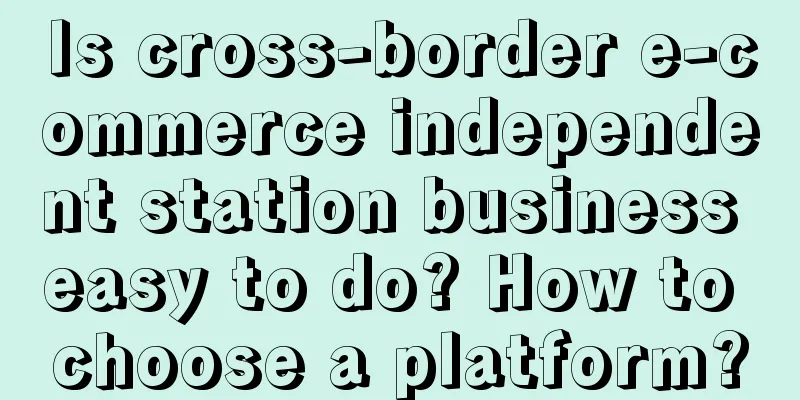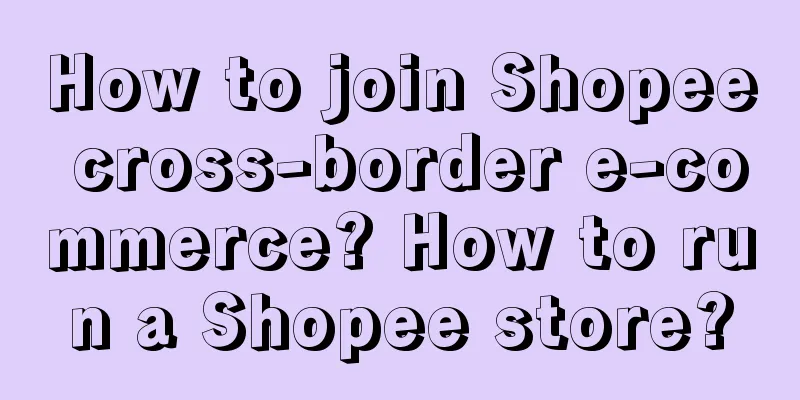Is cross-border e-commerce independent station business easy to do? How to choose a platform?

|
Now more and more seller friends are interested in the prospects of cross-border e-commerce, and they will face a choice, that is, to join a cross-border e-commerce platform or build their own independent website. Before making a choice, I hope everyone can first understand whether the cross-border e-commerce independent website business is easy to do? The core difficulty of independent websites is actually operation and traffic acquisition. The operation of B2C independent websites is different from that of third-party platforms. The operation of third-party websites is based on the regulations of the platform and the attributes of the platform users, and is the operation of commodities. However, B2C independent websites start from scratch. The consumer groups, platform attributes, and user shopping experience that they face are all designed by the enterprise itself, which means that the enterprise must operate both the platform and the commodities, which places very high demands on the operation of the enterprise. Independent station traffic promotion is the most expensive part of independent stations. The continuous expenditure of traffic costs is the reason why many independent stations cannot survive. In fact, from the perspective of ROI, as long as the ROI is high, the price of traffic costs will be low, and vice versa. The core indicator of traffic value lies in the conversion rate. Without a good conversion rate, no matter how much traffic enters the website, it will be wasted. Therefore, to promote traffic: (1) Do a good job of traffic generation. There are many ways to generate traffic, such as Facebook, Google Ads, YouTube video marketing, Google Alliance, commercial advertising, KOL, information flow, remarketing, DSP, SEO, etc. However, different traffic sources have different "quality" of traffic. It is necessary to match the "platform-product-traffic attributes" to determine the optimal traffic source. (2) Traffic conversion can be divided into display volume-click rate-order rate-repurchase rate, and finally form a transaction. Optimization must be done in every link, from display method, picture design to payment design, the user experience must be improved. This part is a test of refined operation. Marketing skills: Cross-border e-commerce requires a professional operation team, such as driving traffic within and outside the site, and providing after-sales service. The current hot trend of cross-border e-commerce is bound to require participants to constantly grab users' attention resources through marketing means. Therefore, marketing is indispensable and a particularly competitive part. 1) Promotion and traffic diversion: Increase the exposure of the website through multiple channels. For example, SEO and SEM work, social media management, cooperation with Internet celebrities and KOLs, EDM marketing, etc. Choose the channel that suits you and do it in depth. 2) Content Marketing: It is no longer the era where you can outperform your competitors by simply posting beautiful pictures. Take the clothing industry as an example. More and more designer stores are popular with people. People admire individuality and the values and life philosophy behind the products. Therefore, content marketing should not only convey creativity and brand warmth, but also use diversified activities and unique brand tone to attract like-minded customers and fans to recognize and pay. 3) Optimization of the site and client: Once a website is put into operation, it does not mean that everything is fine. It is necessary to evaluate the performance of specific modules of the website according to the actual situation of local consumption, and continuously optimize it in order to gain more and more favor from consumers. ("Foreign Trade Independent Station Promotion Skills") In addition, the mobile e-commerce market is booming, with data showing that 54% of online sales come from mobile devices. Research by data agencies shows that consumers are increasingly choosing mobile devices as their preferred channel for online shopping. However, the mobile data conversion rate of cross-border e-commerce is surprisingly low. Contentsquare data shows that mobile consumers have a strong desire to shop, but poor shopping experience often causes consumers to "get off" midway. It can be said that the last step of cross-border shopping has become a conversion problem on the mobile side. It turns out that there is still a lot of room for optimization on the mobile side. Content is something that many novice sellers tend to overlook. Many newly launched independent websites are not perfect in terms of content. The lack of brand story, company profile, FAQ, and return and exchange instructions will greatly reduce the conversion rate of the website. Recommended reading: Can one person do cross-border e-commerce? How to do it? What are the best products to sell in Japanese cross-border e-commerce? What products are available? What cards should I use for cross-border e-commerce payment? What payment tools are available? |
<<: How to set up Amazon discount coupons? Where to set them up?
>>: How to build a cross-border e-commerce independent website? What should I pay attention to?
Recommend
This is too much! Sales analysis can be done so well?
In the world of data analysis, sales analysis is o...
What does Amazon self-operated mean? What is the difference between the mall and self-operated?
The development of Amazon's cross-border e-com...
What is the cost of thc? What is the charging standard?
Everyone knows that when buying and selling goods ...
What is suitable for selling on Shopee Taiwan? Where should I start when selecting products?
Shopee has many sites, but domestic sellers prefer...
eBay US adds video functionality to stores and listings
eBay US recently announced that it will launch new...
What is etsy? How to register?
Etsy is also an e-commerce platform, but most peop...
Which category should I choose for Temu? Can I change the Temu category after it is decided?
As an emerging e-commerce platform, Temu provides ...
Three keys to IP operation - taking "Tina Tony" as an example
Taking "Tina Tony" as an example, this a...
Why is eBay shipping costing hundreds of dollars? Is eBay shipping cost estimated by the seller?
When shopping, eBay is one of the online shopping ...
Is the TradeKey platform effective? How is it?
TradeKey is also an online B2B trading platform. S...
Is Xiaohongshu killing vertical communities?
In the evolution of the Internet content ecosystem...
Alipay’s touch-payment service “casts a wide net” to make up for offline “shortcomings” with convenience?
As two giants, Alipay and WeChat Pay have shown th...
Is the Shopee e-commerce platform profitable? How much is the income?
Now more and more merchants are opening stores on ...
The Internet wave ruthlessly crushes the "community grocery store"
Jack Ma said that the era of pure e-commerce is ov...
Alibaba International Station’s laser product sales ban and restriction regulations
Laser products have been strictly controlled in ma...









